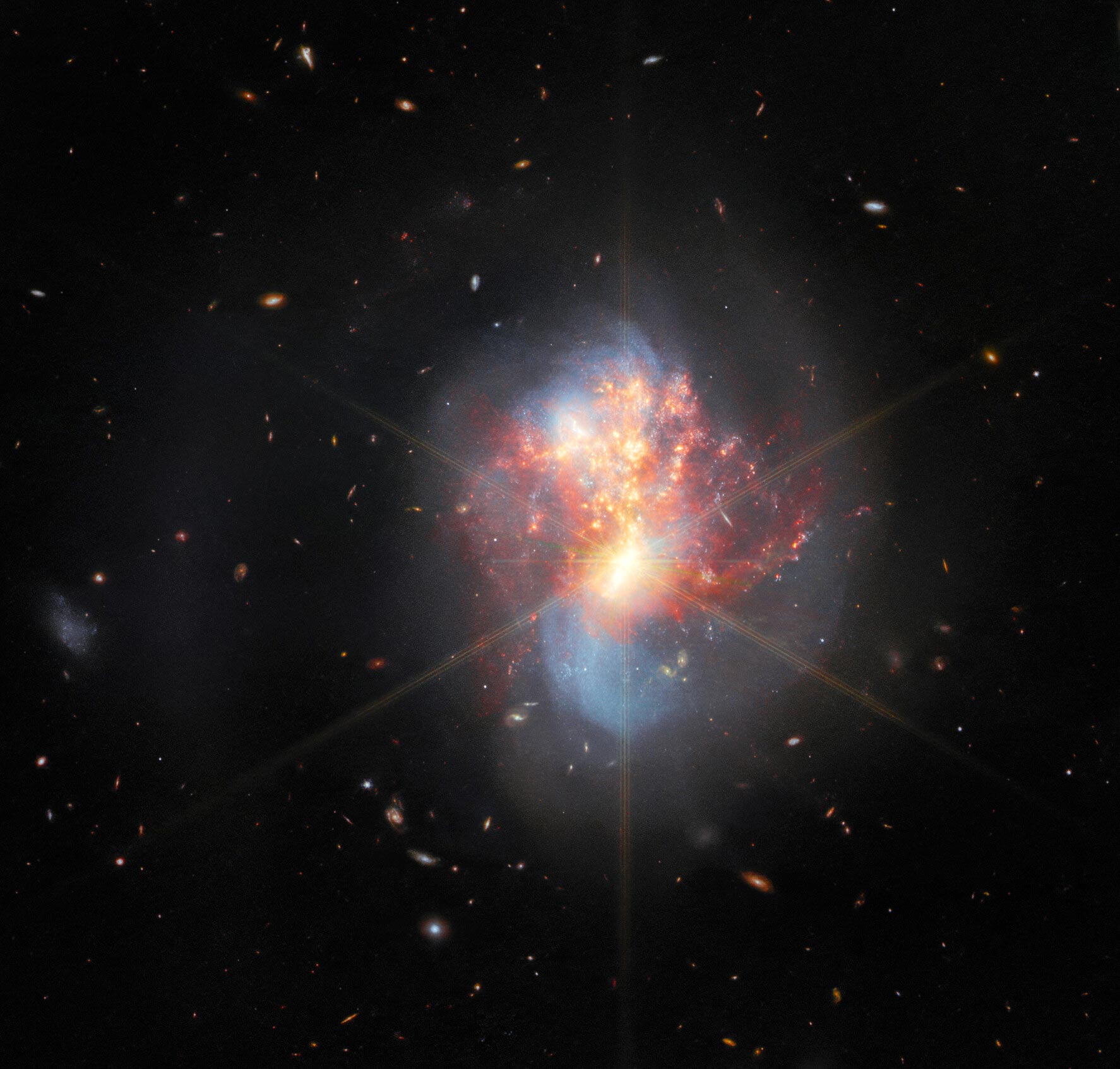
De to galaksene virvler sammen til et enkelt kaotisk objekt i midten. Lange, blå spiralarmer strekker seg vertikalt, svake i kantene. Varm gass sprer seg horisontalt over det, hovedsakelig knallrødt med mange små gullflekker av stjernedannelse. Kjernen i de sammenslående galaksene er veldig lys og utstråler åtte store, gylne diffraksjonsspisser. Bakgrunnen er svart, med mange bittesmå galakser i oransje og blått. Kreditt: ESA/Webb, NASA & CSA, L. Armus & A. Evans
Dette bildet fra[{” attribute=””>James Webb Space Telescope showcases an entwined pair of interacting galaxies known as IC 1623. It lies approximately 270 million light-years from Earth in the constellation Cetus. The two galaxies in IC 1623 are plunging headlong into one another in a process known as a galaxy merger. A frenzied spate of star formation was ignited by their collision. This is known as a starburst and is creating new stars at a rate more than twenty times that of the
Here, the Webb Picture of the Month of merging galaxies IC 1623 A and B is juxtaposed with a new image from the NASA/ESA Hubble Space Telescope. In the Webb MIRI image, the bright core, heated gas and dust, and young star-forming regions are all visible. The Hubble and Webb NIRCAM images show the galaxies distorted spiral arms, while MIRI reveals the faint ghostly glow of interstellar dust. Credit: ESA/Webb, NASA & CSA, L. Armus & A. Evans, Acknowledgement: R. Colombari
This interacting galaxy system is particularly bright at infrared wavelengths, making it an ideal proving ground for electromagnetic spectrum using a trio of Webb’s cutting-edge scientific instruments: MIRI, NIRSpec, and NIRCam. In so doing, they provided an abundance of data that will allow the astronomical community at large to fully explore how Webb’s unprecedented capabilities will help to unravel the complex interactions in galactic ecosystems. These observations are also accompanied by data from other observatories, including the NASA/ESA
Sammenslåingen av disse to galaksene har lenge vært av interesse for astronomer. Det har den faktisk tidligere blitt avbildet av Hubble og av andre romteleskoper. Det pågående, ekstreme stjerneskuddet forårsaker intense infrarøde utslipp, og de sammenslående galaksene kan godt være i ferd med å danne en supermassiv[{” attribute=””>black hole. A thick band of dust has blocked these valuable insights from the view of telescopes like Hubble. However, Webb’s infrared sensitivity and its impressive resolution at those wavelengths allows it to see past the dust and has resulted in the spectacular image at the top of this article, which is a combination of MIRI and NIRCam imagery.
Den lysende kjernen i galaksesammenslåingen viser seg å være både veldig lyssterk og svært kompakt, så mye at Webbs diffraksjonsspiker vises på toppen av galaksen på dette bildet. De 8-kantede, snøfnugglignende diffraksjonspiggene er skapt av samspillet mellom stjernelys og den fysiske strukturen til teleskopet. Den piggete kvaliteten på Webbs observasjoner er spesielt merkbar i bilder som inneholder klare stjerner, som f.eks Webbs første dypfeltsbilde.
Referanse: “GOALS-JWST: Hidden Star Formation and Extended PAH Emission in the Luminous Infrared Galaxy VV 114” av Aaron S. Evans, David Frayer, Vassilis Charmandaris, Lee Armus, Hanae Inami, Jason Surace, Sean Linden, Baruch Soifer, Tanio Diaz-Santos, Kirsten Larson, Jeffrey Rich, Yiqing Song, Loreto Barcos-Munoz, Joseph Mazzarella, George Privon, Vivian U, Anne Medling, Torsten Boeker, Susanne Aalto, Kazushi Iwasawa, Justin Howell, Paul van der Werf, Philip N. Appleton, Thomas Bohn, Michael Brown, Christopher Hayward, Shunshi Hoshioka, Francisca Kemper, Thomas Lai, David Law, Matthew Malkan, Jason Marshall, Eric Murphy, David Sanders og Sabrina Stierwalt, Innsendt, Astrofysiske journalbrev.
arXiv:2208.14507
MIRI ble bidratt av ESA og NASA, med instrumentet designet og bygget av et konsortium av nasjonalt finansierte europeiske institutter (The MIRI European Consortium) i samarbeid med[{” attribute=””>JPL and the University of Arizona.
NIRSpec was built for the European Space Agency (ESA) by a consortium of European companies led by Airbus Defence and Space (ADS) with NASA’s Goddard Space Flight Center providing its detector and micro-shutter subsystems.
Results based on this observation of IC 1623 have been published in the Astrophysical Journal.
